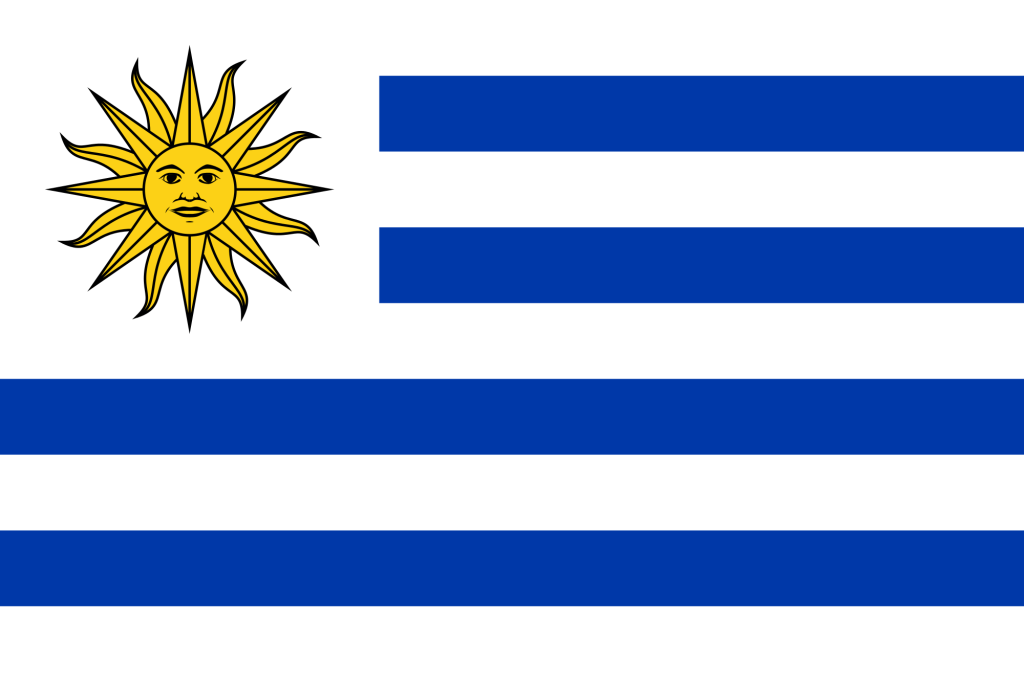Last updated on December 13th, 2022
36. Uruguay’s national flag has nine strips and a sun with a human face in the upper left-hand corner. Their national anthem also contains the line “No one insults the image of the sun!”
37. A majority of its population lives in its capital city, Montevideo.
38. Advertising is done by means of large speakers installed on the tops of vans running across the city. Van drivers use microphones to deliver advertisements.
39. The name Uruguay, when translated, means “river of painted birds.”

40. Amazingly, Uruguay has the world’s poorest politician. Yes, their president lived in simplicity, donating 90% of his salary to noble causes. He owns a one-bedroom house and a three-legged dog.
41. Montevideo, the capital of Uruguay, during the colonial period was a hub for slave trade in South America. As a result, at least 10 percent of the population of the country is descended from slaves.
42. In 1913, Uruguay had a divorce law in force that would allow Uruguayan woman to seek divorce at their sole request. Chile on the other hand, legalized divorce in 2004.
43. Uruguay produced almost 95% of its electricity from renewable sources in 2015.
44. A woman in Uruguay was recently stopped from aborting her child by court. Actually, her boyfriend filled a law suit in the court claiming that he is willing to up bring the child on his own even if the mother of the child is not interested. The court ruled in favor of the boyfriend, which however, is against the rule of the country where abortions are legally permitted until the 12th week of pregnancy. The woman, however has decided that she would appeal against the decision as she does not want to give birth to the child.
45. Philip Morris, a leading tobacco giant, was asked by the court to pay Uruguay a hefty fine of $7 million over a disputed cigarette advertisement.
About the flag of Uruguay

1. Design and Symbolism
The flag of Uruguay is called the National Pavilion. It has nine horizontal stripes of equal width. Four of these are blue, while the rest are white. The upper left corner features the Sol de Mayo or Sun of May – the national emblem of Uruguay. Its golden circle has a face surrounded by 16 alternating straight and wavy rays.
The stripes represent the nine original regional departments of Uruguay. These mirror the US flag that honors the original thirteen colonies. The 1928 design contained nine blue bands, but the high number resulted in thin strips that were difficult to see from a distance. They reduced it to the current number in 1930.
The Sun of May represents the Incan sun god, Inti. Uruguayans associate it with the 1810 May Revolution that ushered in independence from Spain. A legend says that the sun broke through the clouds upon the proclamation of the new government. It was a good omen for the revolutionaries.
2. Adoption
Uruguay initially adopted the flag on December 18, 1828. The modified version became official on July 11, 1830. Joaquin Suarez made the design as the Uruguayan head of state.
3. Technical Details
The flag dimensions have a ratio of 2:3. There is no official color scheme, but most representations use the following values for CMYK: 0-17-91-1 (yellow), 0-49-100-52 (brown), 100-67-0-34 (blue), and 0-0-0-0 (white). In RGB, these are 252-209-22, 123-63-0, 0-56-168, and 255-255-255, with HEX equivalents FCD116, 7B3F00, 0038A8, and FFFFFF.
4. History
During Spanish rule, Uruguay was part of the Viceroyalty of the Rio de la Plata. The government used a striped red-yellow-red flag with the coat of arms of Spain.
Upon the declaration of independence, the United Provinces of Rio de la Plata used a horizontal triband with a white center and light blue edges. They later formed the Liga Federal using the Flag of Artigas.
When the Empire of Brazil invaded its territories, the Flag of Cisplatina flew over the land. It had green and white stripes, with a stylized cross at the center.
The Cisplatine War against Brazil ended in 1828 through the Treaty of Montevideo. Uruguay became an independent state with a flag of light blue stripes and the Sun of May. Two years later, they reduced the number of bars and used a darker shade of blue for better visibility.
5. Other Flags with Official Status
Flag of Artigas
Jose Gervasio Artigas, the national hero of Uruguay, launched a successful revolt against Spanish authorities in the early 1800s. He designed a flag for his troops: a horizontal triband of blue, white, and blue, with a diagonal red stripe to symbolize federalism.
Flag of the Treinta y Tres
The Treinta y Tres Orientales (Thirty-three Orientals) was a revolutionary group that fought against the Brazilian occupation in 1825. Their flag was a horizontal tricolor of blue, white, and red bands. The words “Libertad o Muerte” (Freedom or Death) appear over the white band.
Uruguay – country at a glance
| Independence | 25 August 1825 (from Brazil) |
|---|---|
| Capital City | Montevideo (34°53′S 56°10′W) |
| Largest City | Montevideo (34°53′S 56°10′W) |
| Official Language | Spanish |
| Location | Southern South America, bordering the South Atlantic Ocean, between Argentina and Brazil |
| Population | 3,384,484 (2025 est.) |
| Coastline | 660 km |
| Literacy rate | total population: 98.8% |
| Suffrage | 18 years of age; universal and compulsory |
| Terrain | mostly rolling plains and low hills; fertile coastal lowland |
| Land boundaries | total: 1,591 km |
| Area | total: 176,215 sq km land: 175,015 sq km water: 1,200 sq km (about the size of Virginia and West Virginia combined; slightly smaller than the state of Washington) |
| Government type | presidential republic |
| President | Yamandú Orsi |
| Vice-President | Carolina Cosse |
| National Anthem | "Himno Nacional" (National Anthem of Uruguay) note: adopted 1848; the anthem is also known as "Orientales, la Patria o la tumba!" ("Uruguayans, the Fatherland or Death!"); it is the world's longest national anthem in terms of music (105 bars; almost five minutes); generally only the first verse and chorus are sung |
| National symbol | Sun of May (a sun-with-face symbol) |
| National colors | blue, white, yellow |
| Borders | Argentina 541 km; Brazil 1,050 km |
| Demonym | Uruguayan |
| Currency | Uruguayan peso (UYU) |
| Religion | Non-religious |
| Life expectancy at birth | 78.9 years (2024 est.) Life expectancy at birth indicates the number of years a newborn infant would live if prevailing patterns of mortality at the time of its birth were to stay the same throughout its life. |
| Mean elevation | 109 m |
| Lowest point | Atlantic Ocean 0 m |
| Continent | South America |
| Highest point | Cerro Catedral 514 m |
| Climate | warm temperate; freezing temperatures almost unknown |
| Natural resources: | arable land, hydropower, minor minerals, fish |
| Agricultural land | 87.2% |
| Birth rate | 12.6 births/1,000 population (2024 est.) |
| Death rate | 9.1 deaths/1,000 population (2024 est.) |
| Sex ratio | 0.94 male(s)/female (2024 est.) |
| Industries | food processing, electrical machinery, transportation equipment, petroleum products, textiles, chemicals, beverages |
| Exports | $23.329 billion (2024 est.) beef, soybeans, cellulose, rice, wheat, wood, dairy products; wool |
| Imports | $19.117 billion (2024 est.) refined oil, crude oil, passenger and other transportation vehicles, vehicle parts, cellular phones |
| GDP - per capita (PPP) | $30,700 (2023 est.) |
| Time Zone | UYT (UTC−3) |
| Internet country code | .uy |
| Calling Code | +598 |
| Drives on the | Right |
| Table last updated | August 09, 2025 |
